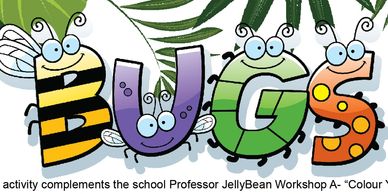Signed in as:
filler@godaddy.com
Signed in as:
filler@godaddy.com

Discover insects in your backyard or school with this fun investigation

Details coming soon

Details coming soon

Details coming soon

Details coming soon
Details coming soon

Do you have the Professor JellyBean
Earth Champion's Guide-Book For Super Awesome Kids
Note: Provided free with Primary Incursion Science Workshops

NOTE: You will be using the "Good Bug" seed-bomb that you created with Professor JellyBean at your school. If you did not do this workshop at school, you can plant your own seeds that will attract good insects like butterflies and bees

Find a spot in your garden or plant the seed-bomb into a plant pot. The seed-bomb does not have to be buried deep, in-fact, you can bury it into the soil so that half of it is sticking out. This will make it easy to find when you need to water it. Keep the soil moist and be patient for your flowers to grow.

Follow the instructions. NOTE: You can download this page if you do not have it. You can conduct this scientific investigation over one day or over several days. Make sure you look at your flowers for the same amount of time during the morning, midday & afternoon. (you can determine how long you want to watch)

Discover how you can help insects and also help Scientists to better understand what is happening to our insects

Insects are super, super important! Without insects, our planet would be a very sad and unhealthy place. Remember, when we take care of Earth, we are taking care of ourselves--So if you want to stay healthy, take care of insects!
CSIROscope suggest 6 things that you can do to help insects thrive.Be sure to check out their page for more information

Rethinking our relationship with Earth and insects
More details coming soon.


Do you have the Professor JellyBean
Earth Champion's Guide-Book For Super Awesome Kids
Note: Provided free with Primary Incursion Science Workshops

Find the Travelling Water Droplet page within your Earth Champion's booklet to create the Water Cycle Experiment.

Carefully cut along the black lines of each picture provided on the correct page. There 4 pictures to cut out.

More details coming soon. We are still working on putting this activity together

More details coming soon. We are still working on putting this activity together

More details coming soon.
When the sun heats the water on the earth’s surface, some of the water changes into a
gas or vapour. The change from a liquid to a gas is called evaporation. After water evaporates,
it rises into the air. This warm vapour mixes with cooler air in the atmosphere to create moisture or
condensation. The moisture that falls back to the earth as rain, hail, sleet, or snow is called
precipitation. When it reaches the earth, it returns to oceans, rivers, lakes and wetlands or
flows into the ground. This process of water moving from the earth into the atmosphere and back to earth again is called the water cycle.
This is nature’s way or recycling one of its most important natural resources: WATER
COOL FACT: WHY ARE CLOUDS WHITE OR GREY IN COLOUR
Note: This is a very simplified explanation.
When you see a white cloud, this cloud is holding less water (water molecules) so there is more space within the cloud for sunlight to reach (to get into the cloud), thus making it white and bright. On the other hand, a cloud holding lots of water (water molecules) takes up more space within the cloud so less light rays can 'get' into the cloud, making a darker, grey coloured cloud.
